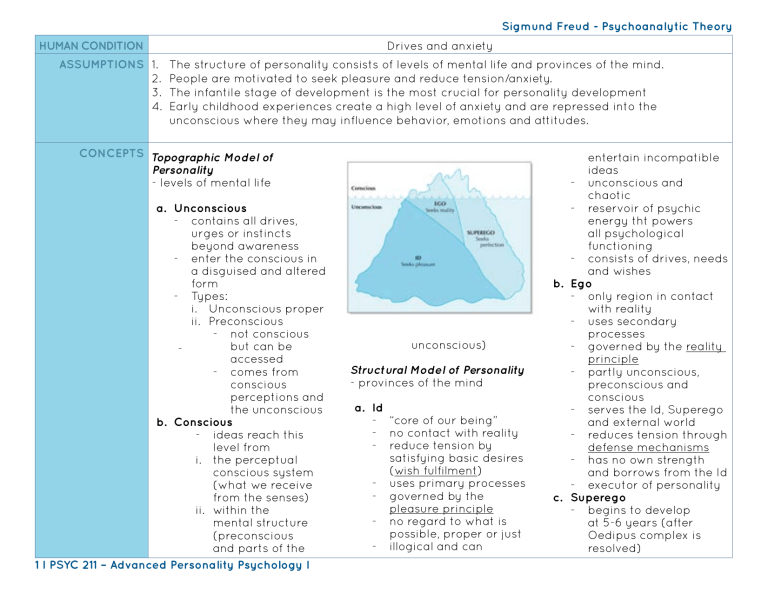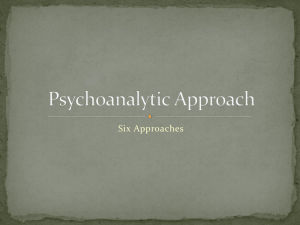
Sigmund Freud - Psychoanalytic Theory
HUMAN CONDITION
ASSUMPTIONS 1.
2.
3.
4.
Drives and anxiety
The structure of personality consists of levels of mental life and provinces of the mind.
People are motivated to seek pleasure and reduce tension/anxiety.
The infantile stage of development is the most crucial for personality development
Early childhood experiences create a high level of anxiety and are repressed into the
unconscious where they may influence behavior, emotions and attitudes.
CONCEPTS Topographic Model of
Personality
- levels of mental life
a. Unconscious
-- contains all drives,
urges or instincts
beyond awareness
-- enter the conscious in
a disguised and altered
form
-- Types:
i. Unconscious proper
ii. Preconscious
-- not conscious
unconscious)
but can be
-accessed
Structural Model of Personality
-- comes from
- provinces of the mind
conscious
perceptions and
a. Id
the unconscious
-- “core of our being”
b. Conscious
-- no contact with reality
-- ideas reach this
-- reduce tension by
level from
satisfying basic desires
i. the perceptual
(wish fulfilment)
conscious system
uses primary processes
(what we receive
-- governed by the
from the senses)
pleasure principle
ii. within the
-- no regard to what is
mental structure
possible, proper or just
(preconscious
-- illogical and can
and parts of the
1 I PSYC 211 – Advanced Personality Psychology I Welison Evenston G. Ty
entertain incompatible
ideas
-- unconscious and
chaotic
-- reservoir of psychic
energy tht powers
all psychological
functioning
-- consists of drives, needs
and wishes
b. Ego
-- only region in contact
with reality
-- uses secondary
processes
-- governed by the reality
principle
-- partly unconscious,
preconscious and
conscious
-- serves the Id, Superego
and external world
-- reduces tension through
defense mechanisms
-- has no own strength
and borrows from the Id
-- executor of personality
c. Superego
-- begins to develop
at 5-6 years (after
Oedipus complex is
resolved)
Sigmund Freud - Psychoanalytic Theory
CONCEPTS
-- innermost core of the
ego
-- represents moral and
ideal aspects of the
personality: striving for
perfection
-- governed by the moral
and idealistic principles
-- has no own energy
-- also has no contact
with the external world
hence, its demands
for perfection are
unrealistic
-- if well-developed
governed through
repression of the ego
-- consists of the following
subsystems
i. conscience
-- results from
experiences with
punishment;
“Should not do”
-- produces guilt
ii. ego ideal
-- results from
experiences with
rewards; “Should
do”
-- produces
inferiority
repression or anxiety.
-- can be divided into two:
Drives or Impulses
-- inner bodily source of
excitement
-- Features of a drive:
a. Source - bodily stimulus
or need
b. Impetus - amount of
energy or intensity of
need
c. Aim - goal and purpose
to reduce the excitation
d. Object - the person or
object through which the
aim may be satisfied
-- operate as a constant
motivational force to which
all behavior can be traced
-- internal stimulus and
cannot be avoided through
flight (as opposed to ext.
stimuli)
-- childhood behavior related
to these impulses are often
punished and leads to
Unconscious
a. Life Impulse (Eros)
-- consists of sexual
(libido) drives
-- governed by the
pleasure principle
-- associated with the
following needs
associated:
i. Narcissism (libido
is self-contained)
ii. love (libido is
directed toward
another)
iii. sadism (libido
is linked to
inflicting pain and
humiliation on
another
iv. masochism (libido
is linked to self
suffering from pain
and humiliation
in the hands of
oneself or another)
b. Death Impulse (Thanatos)
-- consists of the
aggressive drive
whose final aim is selfdestruction
Preconscious
Conscious
X
Id
X
Ego
X
X
Superego
X
X
2 I PSYC 211 – Advanced Personality Psychology I Welison Evenston G. Ty
Sigmund Freud - Psychoanalytic Theory
CONCEPTS
-- can take on various
forms i.e. teasing,
gossip, sarcasm,
humiliation, etc.
Anxiety
-- felt, affective and
unpleasant state
accompanied by a physical
sensation that warns the
person against impending
danger
-- only produced and felt by
the ego
-- serves as an egopreserving mechanism
-- self-regulating because it
precipitates repression
-- consists of three kinds:
a. Neurotic Anxiety
-- apprehension about
an unknown danger
-- originates from id
-- fear of not controlling
one’s inner impulses
b. Moral Anxiety
-- results from conflict
between the ego and
superego
-- also experienced
as an outgrowth of
the conflict between
realistic needs and
the dictates of the
superego
c. Realistic Anxiety
-- an unpleasant, nonspecific feeling
involving possible
danger but may not
involve a specific
fearful object
-- closely related to fear
but not exactly the
same
-- results from the ego’s
dependence on the
external world
Defense Mechanisms
-- established by the ego to
a. avoid dealing directly
with unacceptable
sexual and aggressive
drives
b. defend itself against
anxiety
-- normal and universally used
-- operate on the unconscious
level, denying or distorting
reality
-- when carried to an extreme
may lead to compulsive,
repetitive and neurotic
behavior
-- on its foundation is
Repression (Punishment
+ Suppression > Anxiety
> Repression) - forcing
threatening impulses into
the unconscious
a. Compensation
b. Denial - refusing to
accept an unpleasant
reality
c. Displacement
-- redirecting
unacceptable urges
onto a variety of
3 I PSYC 211 – Advanced Personality Psychology I Welison Evenston G. Ty
d.
e.
f.
g.
h.
i.
j.
k.
l.
people or objects to
conceal or disguise
the original impulse
-- satisfying an impulse
with a substitute
object
Fixation - permanent
attachment of the
libido onto an earlier,
more primitive stage of
development
Identification - modelling
one’s behavior after
someone else
Intellectualization
Introjection
- incorporating
positive qualities of
another person into
one’s own ego; seen
in the resolution of the
Oedipus Complex
Projection - attributing
the unwanted impulse to
an external object
Rationalization - dealing
with an emotion
intellectually to avoid
emotional concern
Reaction Formation
- adopting a disguise
that is the opposite of
the original form and
appears obsessive and
compulsive; limited to
one object
Regression - reverting
back to an earlier stage
of development
Sublimation
- substituting the libido
impulse with a social aim
Sigmund Freud - Psychoanalytic Theory
CONCEPTS
Psychosexual Stages of Development
STAGE 01: Infantile Stage
Oral Phase
Age Up to 1 year old
Erogenous Zone Mouth
Aim Incorporate or receive
into one’s body the
object-choice for
nourishment and
pleasure
(Sadistic) Anal Phase
Phallic Phase
2 years old
3 - 4 years old
Anus
Genitals
Early Anal: receive
pleasure from destroying
or losing objects
Late Anal: receive
pleasure from showing
interest over faeces or
for some, withholding
faeces
Masturbation
Resolving the Male
Oedipus (condition of
rivalry toward father
and sexual desire toward
mother)and Female
Oedipus Complexes
Oral Phase > OralEarly Anal > Late Anal
Sadistic Period (w/ teeth)
STAGE 02: Latency
STAGE 03: Genital
STAGE 04:
Psychological Maturity
Age 4-5 years until puberty
Description -- dormant psycho
sexual development
due to parents’ and
teachers’ suppression
of sexual activity in
young children
1. Adolescents give up
-- might never happen
for some people
auto eroticism and
due to pathological
direct this towards
disorders or neurotic
another (mature
dispositions
reproductive activity)
-- id impulses have no
2. Reproduction is
possible
traces of shame or
3. Penis envy is resolved
guilt; superego moves
beyond parental
identification with no
traces of antagonism
or incest; ego-ideal
is congruent with the
ego
4 I PSYC 211 – Advanced Personality Psychology I Welison Evenston G. Ty
Sigmund Freud - Psychoanalytic Theory
CONCEPTS
Psychosexual Stages of Development
Male Oedipus Complex
Female Oedipus Complex
-- boy wants to be his father > boy desires his -mother and sees his father as a a rival > boy
develops Castration Anxiety (fear of losing
one’s penis based on fear of retaliation from
father)
-- resolved when boy aborts his attempts to
-posses his mother and begins to identify
with his father thus introjecting his father’s
moral code
Assumption:
1. Infants possess a sexual
life and go through a
period of pre genital sexual
development during the
first 4-5 years after birth.
-- the sexual activity
of children is auto
erotic (seek pleasure
from own bodies) and
polymorphous perverse
(children seeking
pleasure from many
areas of the body)
2. Differences in anatomy
determine different
courses in male
and female sexual
development after the
phallic stage
girl develops penis envy (Castration
Complex) > girl desires her mother > girl
blames mother for having no penis > girl
desires father and fantasizes about having a
baby
resolved when girl identifies with mother
3. Freud assumed that
all sexual activities
considered abnormal
(masochism, sadism, etc.)
are at one time normal
sexual activities for
children.
4. Neurosis is the outcome
of an unsatisfactory
or arrested sexual
development, specifically
an unresolved Oedipal
conflict.
Fixation: happens when
the libido is prevented
from obtaining satisfaction
during one or more of the
stages due to frustration
or overindulgence.
5 I PSYC 211 – Advanced Personality Psychology I Welison Evenston G. Ty
5. Character is built up
by responding to one’s
sexuality
Sigmund Freud - Psychoanalytic Theory
CONCEPTS Other Relevant Terms
Phylogenetic Endowment:
inherited unconscious
experiences from our
ancestors
Cathexis:
-an investment
of mental or
-emotional
energy put into a
-- object, or idea.
person,
APPLICATIONS Psychoanalysis/Psychotherapy
--- the “talking cure:
-- primary goal is to help
clients release unconscious
impulses being held in
check thereby freeing
up energy for daily
functioning (ego controls
id and superego impulses)
Methods used:
a. Free Association
i. Freudian Slips /
Accidents / Parapraxes
-- expresses an
unconscious motive
ii. Dream Analysis
-- Manifest dream:
dream as it is
remembered ;
Latent dream:
meaning or motive
underlying the
manifest dream
-- wish fulfilment
vs repetition
compulsion
-- free association
-- condensation
versus displacement
b. Transference
-- refers to the strong
sexual or aggressive
feelings that patients
develop towards
their therapist during
treatment
-- permits patients
to relive childhood
experiences within a
non-threatening climate
-- may be positive or
negative
c. Hypnosis
6 I PSYC 211 – Advanced Personality Psychology I Welison Evenston G. Ty
d. Projective Tests, Symbolic
Behavior
e. Recognizing Resistance:
a variety of unconscious
responses used by patients
to block their own progress
Limitations of psychoanalysis:
a.
a.
a.
Not all old memories can
and should be brought to
consciousness
Not effective with
psychoses or institutional
illnesses
A patient, once cured,
may later on develop
another psychic problem
Sigmund Freud - Psychoanalytic Theory
ABNORMAL
DEVELOPMENT
1. Fixation at one stage: oralsadistic, anal expulsive,
anal retentive, etc.
2. Primary Narcicissm present in infants when
their libido is exclusively
invested in their ego
3. Secondary Narcicissm present in adolescents
who become preoccupied
with personal appearance
and other self-interests
4. Sadism
5. Masochism
6. Paranoia - extreme type of
projection characterized
by powerful delusions of
jealousy and persecution;
characterized by
repressed homosexual
feelings towards the
persecutor
7. Voyeurism - obtaining
pleasure rom seeing sexual
organs or sexual acts
LIMITATIONS OF -- Personality as driven purely
THE THEORY by instinct
-- Does not recognize that
personality can still develop
beyond 6 years of age
-- Focuses heavily on
psychological disorders
-- Very male-biased
-- Lack of scientific rigor
{{ Not based on
experimental investigation
but subjective
observations
{{ Freud relied on case
studies and his sample
population were the
middle to upper class of
European society
Criteria of a Useful Theory
1. Average in ability to
generate research
2. Very low in ability to
generate falsifiable
hypotheses since Freud’s
ideas can also be
explained by other models
3. Moderate ability to
organize knowledge
since its emphasis
on the unconscious is
loose and flexible that
seemingly inconsistent
data can coexist within its
boundaries
4. Low on ability to guide the
practitioner since many
psychotherapists use other
frameworks
5. High on internal consistency
as far as consistency
of ideas are concerned
but low if concepts
should have operational
definitions
6. Low on parsimony
7 I PSYC 211 – Advanced Personality Psychology I Welison Evenston G. Ty
Sigmund Freud - Psychoanalytic Theory
CONCEPT OF
HUMANITY
1. Deterministic since Freud
believed most behavior
is determined by past,
childhood events and
rooted in the unconscious
2. Pessimistic as the human
condition is based on
anxiety caused by conflict
between life and death
instincts over which
we have no control as
these operate in the
unconscious
3. Based on causality as
individuals navigate
between the life and
death instincts and
personality develops from
the reactions to these
forces which individuals
compulsively repeat
4. Believed personality was
driven by unconscious
motivation
5. Biological since Freud
believed infantile
phantasies and anxieties
are rooted in biology
6. Mid-way between
presenting personality as
unique and similar since
Freud believes humanity
has many similarities
(due to phylogenetic
endowment) but that
individual early childhood
experiences shape
personalities.
References
Engler. (2014) Personality Theories - An Introduction. Belmont, CA: Wadsworth Cengage Learning.
Feist, J., & Feist, G. J. (2008). Theories of Personality (7th ed.). Boston: McGraw-Hill.
8 I PSYC 211 – Advanced Personality Psychology I Welison Evenston G. Ty





